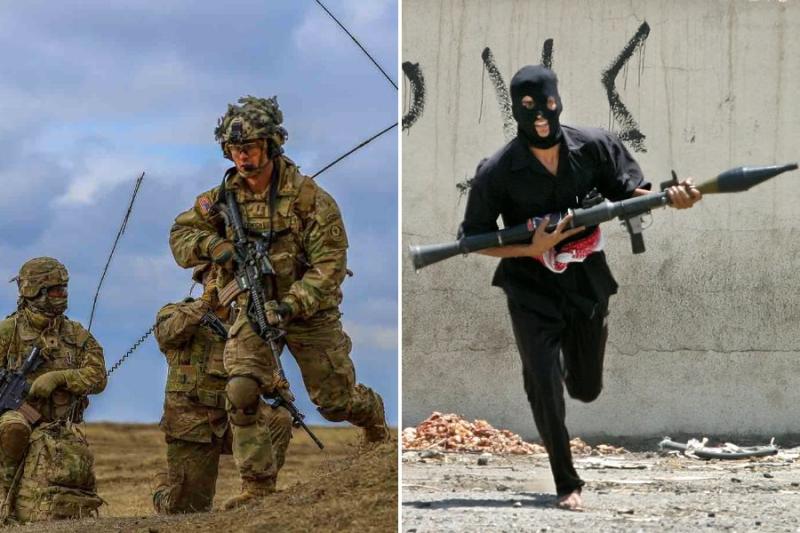Conventional war and guerrilla war are inherently distinct in terms of strategy, tactics, and participants. Conventional war entails large-scale conflicts between well-defined and frequently state-sponsored armed forces. Battles are typically conducted hierarchically, with a distinct chain of command and battle lines. Each party engages in open combat in accordance with the rules of warfare outlined by international law.
On the other hand, guerrilla war is characterised by using unconventional tactics by small, irregular groups of combatants, who are frequently non-state actors or ordinary citizens. Guerrilla combatants commonly employ ambushes, hit-and-run attacks, and sabotage to counter their opponents’ superior resources and organisation. They merge with the civilian population, making it challenging for conventional forces to target them effectively. Guerrilla warfare frequently disregards conventional rules of engagement and emphasises psychological warfare and garnering the support of the local populace.
What is Conventional War?
Conventional war is a large-scale armed conflict between two or more opposing forces, usually organised by the government. These forces have a clear chain of command and different military ranks that follow a hierarchy. Conventional warfare uses weapons that have been used for a long time, like guns, artillery, tanks, and jets. It also uses tried-and-true strategies and tactics, like frontal attacks, overhead bombardments, and large-scale ground operations. In conventional war, the main goal is to defeat the enemy by destroying their military powers, capturing key strategic points, or causing them to surrender. Most battles happen in well-defined “theatres of operations,” with each side holding certain areas and keeping clear “battle lines.” In these wars, there are often many troops, tools to help with logistics, and complex command and control structures.
In a conventional war, both sides usually follow officially recognised rules of war, such as the Geneva Conventions, which set rules for how to treat prisoners of war, civilians, and wounded soldiers. These rules are meant to ensure that people affected by the conflict don’t have to endure too much pain and that a minimum level of humanity is kept during the fighting. Most of human history has been shaped by conventional wars, such as the World Wars, the Korean War, and the Gulf War. But as global politics and technology have changed, so has the nature of war. Unconventional or asymmetrical wars, like guerilla wars and insurgencies, have become more common in recent years.
What is Guerrilla War?
Guerilla war, also called guerrilla warfare, is irregular warfare in which small, independent groups of fighters use unconventional tactics and strategies to fight against a bigger, better-equipped, and more organised enemy, often a state-sponsored military force. These fighters, called guerillas or insurgents, are usually not part of the government or ordinary citizens working for a political, social, or ideological cause. In guerilla warfare, it’s essential to be mobile, sneaky, and able to adapt. Guerilla fighters confuse and demoralise their opponents using ambushes, hit-and-run attacks, raids, and mischief. Instead of fighting directly and on a large scale, guerilla fighters exploit the enemy’s flaws by attacking supply lines, communication systems, and infrastructure to slow them down.
The help and cooperation of the local people is a key part of guerilla warfare. Guerrillas often look like regular people, making it hard for regular forces to find and attack them. By getting to know the people in the area, guerillas can get information, get access to tools, and find new members. Most of the time, standard rules of engagement aren’t followed in guerilla warfare. This can lead to violations of international humanitarian law. Psychological warfare is also important, as guerillas try to bring down the enemy’s confidence and make them feel insecure. In many wars, such as the Vietnam War, the Cuban Revolution, and the Afghan resistance against the Soviet Union, guerilla warfare has been a successful way to fight against stronger forces.
Difference Between Conventional War and Guerrilla War
Conventional wars are large-scale wars fought by conventional military forces adhering to international rules of war and employing conventional tactics and weapons. The battle lines are well-delineated, and the goals of the conflict are well-defined. In contrast, guerilla war is fought by loosely organised bands of fighters who use unusual strategies such as ambushes, hit-and-run attacks, and sabotage. To gain local support and take advantage of enemy weaknesses, guerrillas frequently blend in with civilian communities. In contrast to conventional conflict, guerrilla warfare typically does not adhere to standard rules of engagement and instead focuses on psychological warfare to demoralise and disrupt the opposition. Here are the main differences between conventional war and guerrilla war:
Actors Involved
Small, irregular groups of combatants fight guerrilla wars. They are mostly non-state actors or civilians. In contrast, conventional wars are fought between state-sponsored military forces.
Strategy and Tactics
Frontal assaults and aerial bombardments are examples of conventional military operations that rely on tried and true strategies. Ambushes, hit-and-runs, and sabotage are just some of the unusual methods used in guerilla warfare to exploit the enemy’s vulnerabilities.
Organisation and Hierarchy
In contrast to conventional ones, guerrilla forces are not centralised and are instead composed of autonomous cells that may respond to changing circumstances.
Rules of Engagement
Conventional wars are fought per the Geneva Conventions and other international treaties. Guerrilla war frequently ignores these standards, which could lead to violations of international humanitarian law.
Reliance on Local Population
The local populace is crucial in providing guerrillas with intelligence, supplies, and recruits. While interacting with the local people, conventional forces typically rely on preexisting logistical and intelligence structures.
Psychological Warfare
Guerrilla war relies heavily on psychological operations to demoralise the enemy and sow fear. Psychological operations are still used in conventional wars, although they are less vital to the overall strategy.






